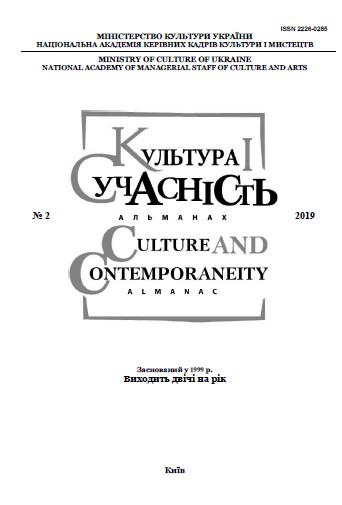СУЧАСНІ ТЕНДЕНЦІЇ ГЕО-ПЛАСТИЧНИХ ФОРМ У ЛАНДШАФТНІЙ АРХІТЕКТУРІ
OVERVIEW OF MODERN TENDENCIES OF GEO-PLASTIC FORMS IN THE LANDSCAPE ARCHITECTURE
Author(s): Viacheslav MelnykSubject(s): Architecture, Environmental interactions, Sociology of Art
Published by: Національна академія керівних кадрів культури і мистецтв
Keywords: landscape art; landscape geoplastics; landscape complexes; artistic expressiveness; art;
Summary/Abstract: The purpose of the article is to trace and determine the principles and problems of the formation of geoplastic elements, taking into account the world practice of landscape art of the XX - early XXI centuries. Methodology of the article consists of the application of general scientific and particular approaches and research methods for the designated topic, which allows us to study the theoretical and practical aspects of landscape designing of the environment. The analytical, historical method, and the comparative method are used in the systematization and generalization of theoretical material. While working with illustrative material, methods of morphological, compositional, artistic, and complex analysis were applied. Scientific novelty. The study of landscape architecture analyzes the history of the use of landscape geoplastics in landscape art, which focuses on the technology of creating geoplastic forms that build artistic expressiveness of large landscape complexes based on the traditions of landscape art. Conclusions. Geoplastics - one of the most promising areas in contemporary landscape architecture - is essentially a kind of vertical planning that, by and large, pursues architectural and artistic goals. Modern technology allows you to create almost any relief, it imposes on the architect a special responsibility for the choice of a particular solution, depending on the knowledge, taste, certain creative position. The composition issues here are closely related to ecology, agrotechnics and require serious scientific analysis and experimental practical work. The goals of creating relief in gardens and parks can be both utilitarian and aesthetic. The first is the construction of noise-proof breaststroke. Relief modeling can also pursue purely artistic goals, for example, to enhance the artistic expressiveness of the landscape in flat terrain, to create earth embankments - a pedestal, to close undesirable species perspectives, to organize visual frames, to deepen the ground floor, and to form so-called sculptures. The global landscape design experience has the considerable potential to create a high level of comfort and environmental sustainability in an urban environment. The tasks of modern architects and landscape designers consist of adapting landscape principles to the consumer, and introducing comfortable foundations and developments to create geoplastics in areas for various purposes that help maintain and develop an environmentally balanced local environment.
Journal: Культура і сучасність
- Issue Year: 2019
- Issue No: 2
- Page Range: 188-191
- Page Count: 4
- Language: Ukrainian

